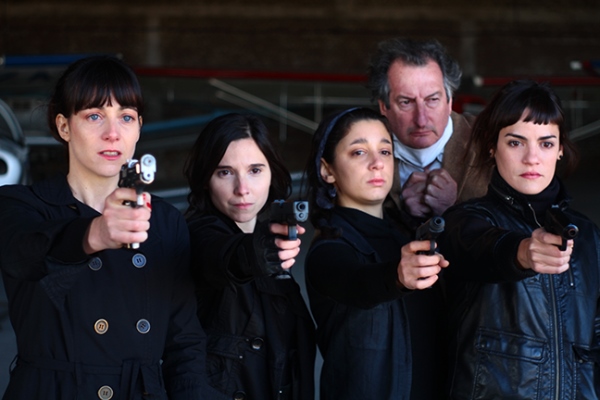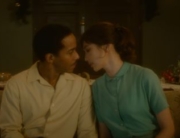![]() In Greek mythology, there is a famous hybrid, part lion, goat, and serpent, named the chimera, an out of control monster whose body is disproportionate. Chimera also refers to impossible enterprises dreamed by often delusional minds. The movie La Flor is a chimera in both meanings: a hybrid of multiple film genres totaling 14 hours, with the proposition that it can only be seen in theaters over several days. Its writer/director, Argentinian filmmaker Mariano Llinás, has stated his reluctance against the streaming model, and La Flor could be interpreted as a response (or a joke) to the streaming menace by creating a binge-watching experience in the realm of traditional exhibition.
In Greek mythology, there is a famous hybrid, part lion, goat, and serpent, named the chimera, an out of control monster whose body is disproportionate. Chimera also refers to impossible enterprises dreamed by often delusional minds. The movie La Flor is a chimera in both meanings: a hybrid of multiple film genres totaling 14 hours, with the proposition that it can only be seen in theaters over several days. Its writer/director, Argentinian filmmaker Mariano Llinás, has stated his reluctance against the streaming model, and La Flor could be interpreted as a response (or a joke) to the streaming menace by creating a binge-watching experience in the realm of traditional exhibition.
Once you are lucky to appreciate the entire project, you are introduced to an immersive world of pure fiction that nurtures viewers’ desires to be enthralled by endless stories that open their imaginations. When so many watch entire seasons of a television series in a couple of days, why is it so hard to go back to the movies for the same?
What initially looks like a challenge to the patience of spectators gradually becomes a game, where the audience follows rules exposed in a splendid prologue, starring the director himself. Llinás shows a notebook, in which he draws a flower while explaining that his movie is divided into six self-contained parts, with four unfinished stories and two with endings. The stories never converge, and the only thing in common among the chapters (except the fifth) is the presence of the same four actresses: Elisa Carricajo, Valeria Correa, Pilar Gamboa, and Laura Paredes. According to the director, the movie is about them and for them.
The highlights are the first four episodes. Each offers an opportunity for the actresses to shine. The first episode is a B-horror movie about an ancient mummy and a curse that affects a female anthropological team—and cats. The second is a romantic musical melodrama about an ex-couple who were once a famous musical duo, interposed with a delirious subplot about a secret cult finding a rare scorpion that hides the secret of eternal youth.
The third and best film—also the longest and most ambitious and political—is a spy tale set during the Cold War–era. In this brilliant segment, an expert mercenary hired to kill traitors has the challenge of killing four female spies. Meanwhile, the women think they are just completing a new mission together. Each has a backstory, fully narrated in extensive flashbacks. The fourth story takes a farcical, referential approach to a director trying to finish a movie starring the four actresses, although he prefers to film trees. This one has a deliciously insane twist that includes detectives, witches, and books.
The final two episodes are more experimental than the rest (in form, not in content), emulating the style of silent cinema. The fifth episode is an intentional, frame by frame, remake of the comic A Day in the Country by Jean Renoir (1936), and the sixth centers on a historical tale about a group of white women escaping their abduction by Natives in an unnamed location.
La Flor is more absorbing than frustrating, even if it requires voluntary submission to its running time. Though Llinás doesn’t always resolve his stories, you get enough of an understanding to complete the missing pieces. His stories end before they become predictable, and the next one is always instantly intriguing. Through constant voice-overs and arbitrary interruptions, the richest pleasures are not in the plots. It’s in the unlimited wonder of a storytelling universe where everything is possible: a quiet woman finally bursting out in angry verbosity, lovers who pretend they don’t love each other anymore until one song ignites the fire again, metaphors about tsetse flies and traitors, a kidnapped man happy to count the stars, epiphanies on tress and how to film them correctly, an apocryphal Casanova memory coming to life, or 40 minutes of end credits that captures an arresting sunset upside down.
At first, considering its 808 minutes, this multigenre monster has everything to lose. However, its sole existence is a triumph, because La Flor is a colossal artistic achievement by a filmmaker who can be declared genius, mad, or an impostor (or all of them). Contrary to what you might think, this is an entertaining movie where levity and moving crowd-pleasing intentions blend graciously with intellectual references and an intricate structure. Luckily, it’s predestined to inspire a well-deserved cult after more audiences discover it, and the question about watching La Flor, one of the more exceptional films in recent South American cinema, shouldn’t be if but when.

















Leave A Comment